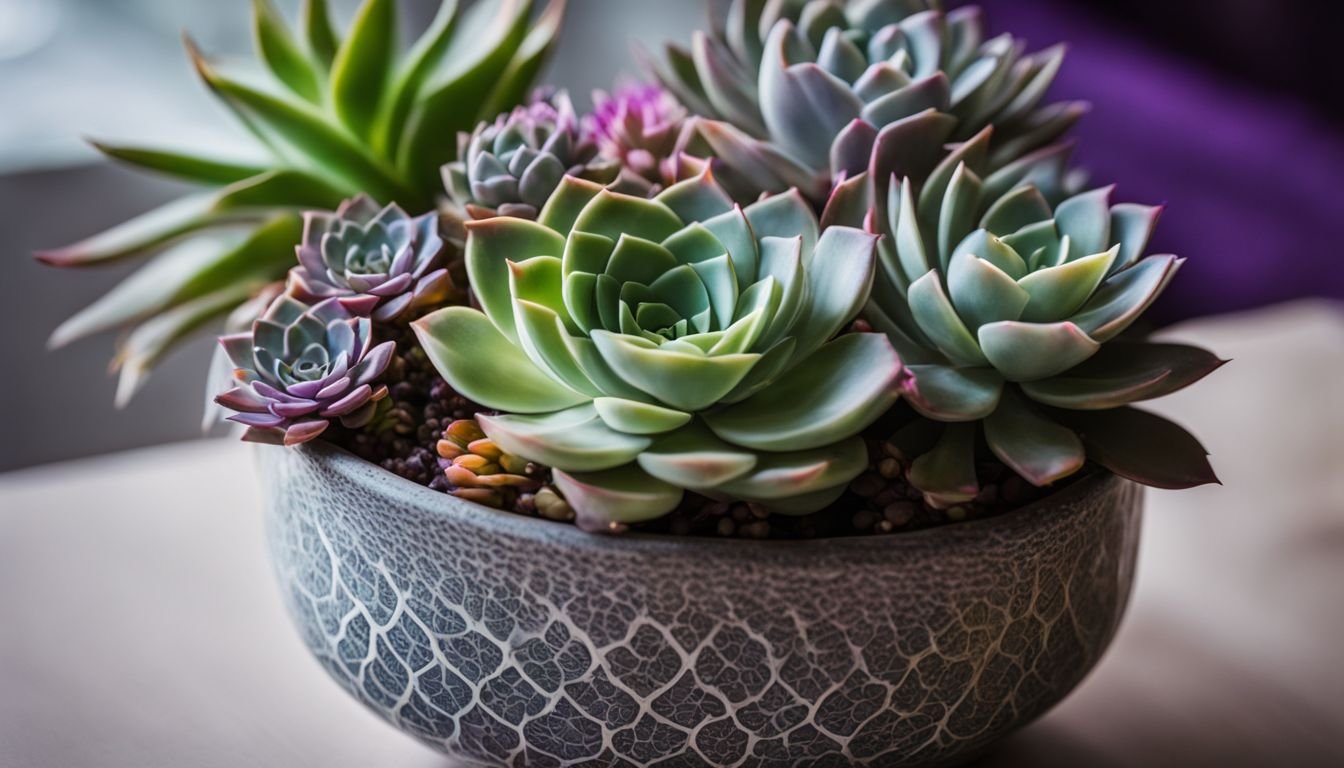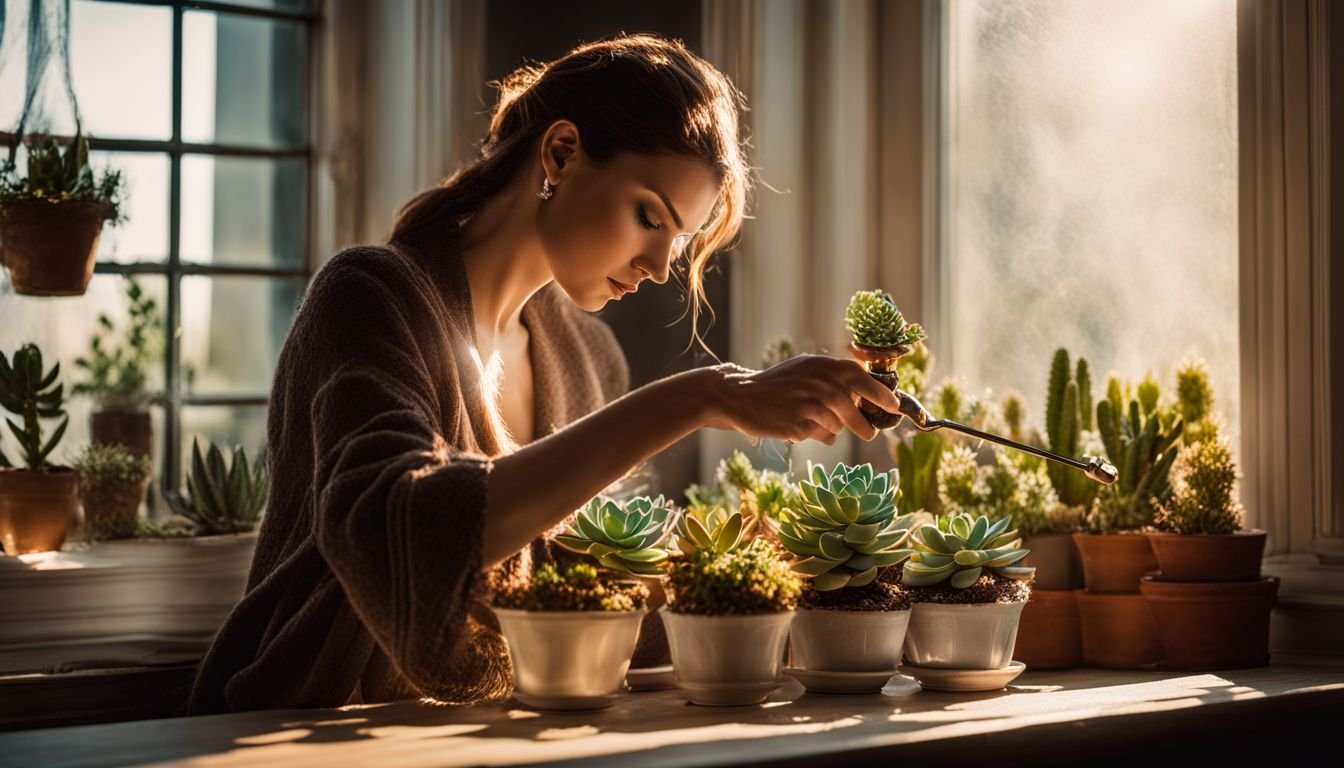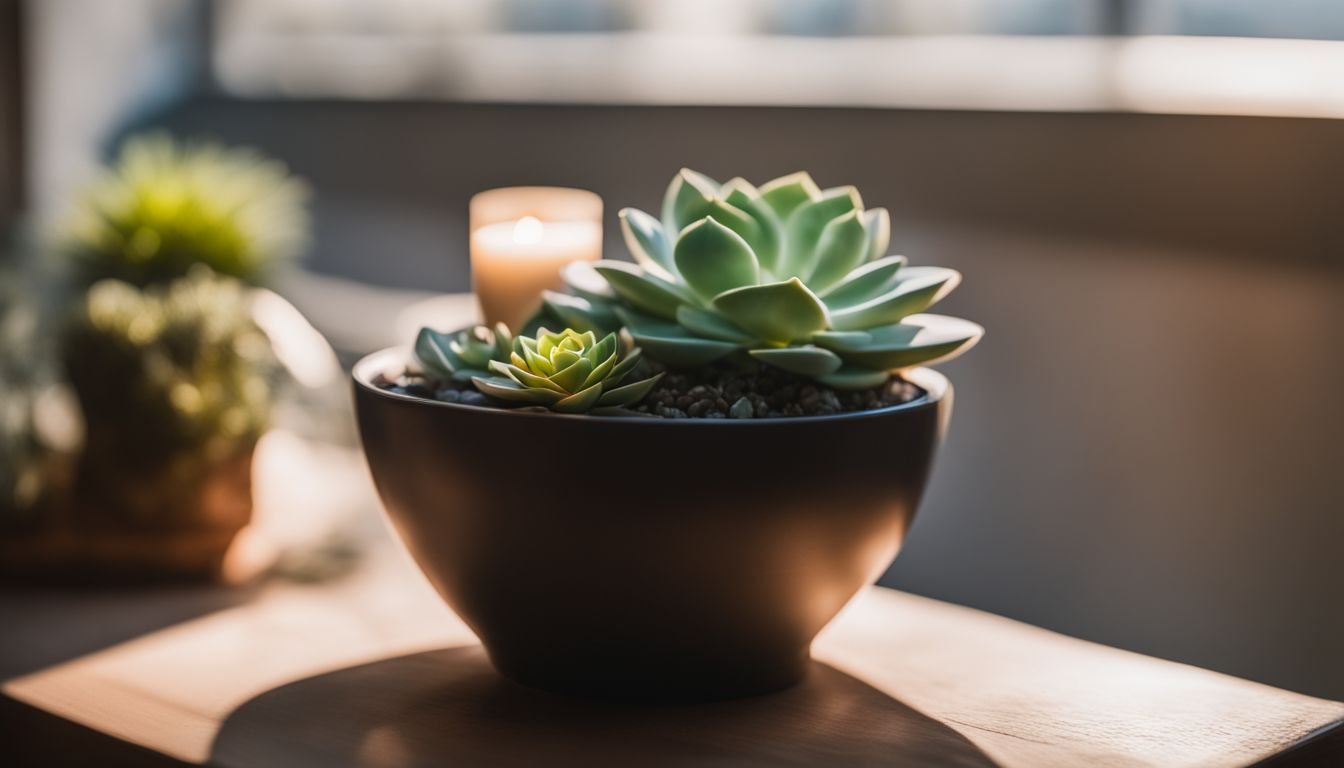Are you a plant lover in Australia finding it a bit tricky to keep your candle succulent fighting fit? You’re definitely not on your own. Many of us find these distinctive plants a challenge, but they’re absolutely worth the effort.
The candle plant, with its quirky sausage-shaped stems, is an absolute stunner that hails from South Africa and can stop anyone in their tracks with its beauty. We’ve seen firsthand how disheartening it can be when our cherished plant doesn’t thrive despite all our care and attention.
That’s why we’ve put in the hard yards researching every tip and trick for successful candle succulent care.
In this guide, we’re sharing straightforward steps to make sure your candle succulent gets everything it needs – from nailing the perfect light conditions to mastering the art of watering and beyond.
We’ll also help you tackle any typical issues head-on with simple solutions so your little green mate can flourish. Keen to see your succulent terrarium candle come into its own? Stick around!
Key Takeaways
- Candle Succulents need well – draining soil and pots with holes to help prevent root rot.
- They thrive in partial shade outdoors and bright sunlight indoors but watch out for too much direct sun which can stress them.
- Allow the soil to dry out completely between watering sessions, cutting back during their dormant summer period.
- Keep your plants healthy by watching for pests like aphids, mealybugs, and spider mites, treating them quickly if they appear.
- Propagate your Candle Succulents through seeds or cuttings to expand your collection or share with friends.
Understanding Candle Succulents
 Candle Succulents, or Curio articulatus, hail from South Africa and are a proud member of the Asteraceae family. These unique plants catch the eye with their sausage-like stems that can stretch up to 2 feet tall.
Candle Succulents, or Curio articulatus, hail from South Africa and are a proud member of the Asteraceae family. These unique plants catch the eye with their sausage-like stems that can stretch up to 2 feet tall.
Their grey-green color is striking, marked by darker green or purple patterns that add an exotic touch to any home decor. They thrive in partial shade outdoors and love bright sunlight when placed indoors.
This makes them a perfect fit for Australian homes where sunlight is abundant but direct exposure can be moderated.
For those of us keen on adding a bit of nature’s marvel to our living spaces without committing too much time, Candle Succulents could be just what we’re looking for. They demand well-draining soil paired with pots that allow water to escape easily; securing this setup ensures they flourish inside your home.
Despite their need for occasional watering – as they don’t like being left dry too long – these succulents stand out as quite forgiving houseplants for Australians at all levels of gardening experience.
Additionally, it’s vital we remember these stunning plants come with a word of caution: they’re toxic and should be kept out of reach from children, pets, or livestock.
“Candle Succulents blend exotic beauty with low-maintenance care, making them ideal for busy plant lovers.”
Essential Care Tips for Candle Succulents

We know you love your candle succulents and want them to thrive. Keep reading for some top tips to keep these beauties looking their best.
Appropriate Lighting
Finding the right light for your candle succulent is key to keeping it happy and healthy. These plants love partial shade if they’re outside and bright sunlight when they’re inside.
This makes them perfect for Australians who have both garden spaces and sunny windowsills. If you place them in too much direct sun outdoors, their leaves can get a bit purple from the stress of intense light.
Inside, aim to give them a spot where the sun kisses them gently through a window.
Adjusting lighting as seasons change ensures your candle succulent thrives year-round. During summer months, remember that this plant takes a little nap – it goes dormant. So, during this time, make sure it’s not baking in too hot of a spot.
Moving plants around might be necessary as our Aussie sun shifts its position in the sky throughout the year.
Keeping these simple lighting tips in mind will help your candle succulent grow strong and lush, with those beautiful green leaves showing just a hint of purple – like they’re blushing! No need for fancy equipment or constant monitoring; just watch how its colors tell you about its comfort level with the light it receives.
Ideal Watering Practices
To ensure your candle succulent stays healthy, let the soil completely dry out before you water it again. This mimics the plant’s natural environment and prevents overwatering, leading to problems like root rot.
During summer, when these plants take a break and rest, cut back on watering. This gives them a chance to thrive without being overwhelmed by too much moisture.
In winter, be extra careful with watering. Cold weather combined with wet soil can harm your succulent’s roots. For new cuttings just starting to grow their own roots, keep the soil barely moist to help them get established without risk of decay.
Think about how in South Africa, where our succulent candle friends come from, the rains are infrequent but heavy—try to replicate this by giving your plants a good soak and then letting them dry out fully between waterings.
“Water deeply yet infrequently for strong growth.”
Now that we’ve covered how critical proper hydration is for your succulents, let’s move on to ensuring they have the perfect soil mix.
Suitable Soil Mix
Choosing the right soil mix plays a vital role in the health of your Candle Plant. We need to ensure that the mix provides excellent drainage, as these unique plants thrive best in well-draining conditions.
A blend containing sandy or gritty materials works wonders, aiding in mimicking their natural arid environment. This setup not only supports their growth but also prepares them for drought periods, a common challenge they face in their habitat.
For those looking to grow Candle Plants indoors, selecting a vessel with at least one escape route for water is crucial. This prevents excess moisture from sitting at the bottom and causing root decay—a common issue for many garden enthusiasts.
Moreover, this careful setup aids in successful propagation efforts, ensuring our beloved succulents can multiply and flourish without hindrance. Always handle these plants with care due to their toxic nature, especially during potting activities where direct contact with soil is frequent.
Temperature and Humidity Needs
Candle Succulents thrive in specific climate conditions. They can handle cold snaps as chilly as -3.9 to 10 °C. This resilience makes them perfect for places in Australia that fall within USDA hardiness zones 9b to 11b.
So, if you live in these areas, your Candle Plant will feel right at home outdoors during most times of the year.
Managing the moisture around your succulent is also crucial. Unlike tropical plants, Candle Succulents prefer a drier atmosphere. Keeping them too damp can lead to problems like rot, which no plant lover wants.
Aim for a balance; water when the soil feels dry but don’t let it sit waterlogged.
Keep these temperature and humidity tips in mind and watch your Candle Succulents flourish! With just the right amount of warmth and dry air, they’ll grow healthy and strong, adding beauty to your gardening space or indoor collection alike.
Common Problems and Solutions in Candle Succulent Care
Caring for candle succulents sometimes brings up challenges like too much or too little water. We offer tips to get the right balance and tackle pests that might love your plants as much as you do.
Overwatering and Underwatering
Watering our candle succulents right keeps them healthy and happy. Let’s get the balance just right by avoiding too much or too little water.
- Look for signs your plant might be getting too much water. Yellow or droopy leaves often mean we’ve been a bit heavy-handed with the watering can.
- On the flip side, a succulent craving more water shows it through shrivelled stems and leaves.
- To stop overwatering, choose a container that lets excess water out easily. Make sure it has holes at the bottom.
- We must allow the soil to dry out before giving our plants another drink. This prevents root rot by ensuring roots aren’t sitting in wet soil for long.
- For plants that haven’t had enough water, gradually increase how much you give them. Check that the soil gets moist all the way through but doesn’t stay soggy.
- Pick a growing mix that drains well to help manage water levels better. This kind of soil helps keep our green friends from drowning or thirsting.
- Cut back on watering during the summer months as candle plants take a break and might drop their leaves as they snooze.
- Remember, these beauties can be harmful if eaten, so keep them away from curious munchers like kids and pets.
We avoid tipping our care into too much or too little by watching carefully and adjusting as needed, using well-draining pots and soil to help us along the way.
Light Issues
After tackling the challenge of watering our candle succulents correctly, we now shift our focus to another crucial aspect of their care – light issues. Getting the lighting right for these plants is not just about avoiding dim corners or direct sunlight; it’s about understanding what truly makes them thrive.
- Finding the Perfect Spot: Our candle plants love basking in natural light, but not all day under the harsh Australian sun. Choose a spot where they can enjoy bright, indirect sunlight for most of the day. This helps prevent the leaves from turning a dull green or flushed purple due to lack of light.
- Managing Winter Light: During winter, when days get shorter and darker, move your succulent closer to windows or sources of natural light to support its flowering process. They need enough sunlight to maintain health and vibrancy even in colder months.
- Avoiding Direct Sunlight: While it might seem counterintuitive, direct sunlight can actually do more harm than good by causing sunburn on the leaves of your candle succulent. Use sheer curtains or blinds as a barrier if your plant sits near a window that gets strong afternoon sun.
- Dealing with Leggy Growth: If you notice your candle plant stretching towards the light with elongated stems and pale leaves, it’s craving more sunlight. Relocate it to a brighter area but do so gradually to avoid shock from sudden exposure to intense light.
- Rotating Your Plant: Ensure even growth on all sides by rotating your plant every few weeks. This prevents lopsided growth and ensures that each part gets its fair share of sunlight.
- Using Artificial Light: For those difficult-to-light areas or during particularly dark winters, consider using grow lights designed for plants. These can provide an excellent alternative source of light, mimicking natural sunlight’s spectrum without overheating or damaging your succulent.
By paying close attention to these lighting needs and making adjustments as necessary, we ensure our candle succulents remain healthy and vibrant year-round. Simple acts like choosing the right spot and monitoring seasonal changes make a big difference in preventing common lighting issues before they start affecting our beloved plants.
Pest Infestations
We all love our candle succulents, but pests like aphids, mealybugs, and spider mites can cause serious trouble. These unwelcome visitors damage the plant, leading to yellow or brown leaves and even wilting. Here’s how we can tackle pest infestations in candle succulents:
- Inspect your plants regularly for early signs of pests. Look for sticky residue or webbing on the stems and leaves.
- Isolate any infected plants immediately to stop pests from spreading to your other succulents.
- Wash off mild infestations gently with water or use a cotton swab dipped in alcohol for stubborn pests.
- Apply insecticidal soap or neem oil treatments to affected areas of the plant, following product instructions closely.
- Introduce natural predators like ladybugs into your garden as biological control agents against aphids and mealybugs.
- Ensure your candle succulent gets the right amount of sunlight and water it needs. Healthy plants resist pests better.
- Mix suitable soil that drains well to prevent waterlogging, which attracts pests.
- Consult with a professional gardener if you’re not sure how to handle severe infestations.
By keeping our eyes open and taking quick action, we can protect our candle succulents from these pesky invaders. Keeping them healthy requires some effort, but it’s worth it to see them thrive without the threat of pests!
Propagating Candle Succulents
Propagating Candle Succulents opens up a world of possibilities for Aussie plant enthusiasts. It’s a simple and rewarding way to expand your garden or share unique plants with friends.
- Choose healthy parent plants: Look for Candle Succulents that are robust, disease-free, and have plump leaves. A strong parent is key to successful propagation.
- Prepare your tools: Grab some clean scissors or a sharp blade. Make sure they’re sterilised to prevent any form of infection from spreading to the cuttings or seeds.
- Collect seeds or cuttings: If you’re using seeds, wait until they ripen on the plant before collecting them. For cuttings, snip off a healthy leaf or stem segment.
- Let cuttings dry: Allow the cut segments to air dry for a few days until the cut end forms a callous. This step is crucial for preventing rot once planted.
- Plant in suitable soil: Use a well-draining mix designed for succulents or cacti. This encourages strong root growth without waterlogging.
- Provide optimal light and water: Place your newly planted seeds or cuttings in bright, indirect light and mist lightly with water when the soil feels dry.
By following these steps, you will soon see new growth, signifying that your propagation efforts have been successful. Sharing these new plants can bring joy to fellow succulent lovers across Australia, encouraging a vibrant community of enthusiasts who appreciate the beauty of Candle Succulents.
Visit Our Partner Site for More Plant Care Tips
After learning how to propagate candle succulents, you might be eager for more gardening advice. We’ve got you covered. Hop over to our partner’s website where a treasure trove of plant care wisdom awaits Australian garden enthusiasts like us.
There, you’ll find detailed guides on nurturing not just candle plants but a whole range of succulents and other greenery loved across Australia.
Our allies understand the unique challenges and joys that come with gardening in Australia’s diverse climate zones. They offer tips practical for both beginners and seasoned gardeners looking to deepen their knowledge.
Whether it’s mastering the art of using well-draining soil or ensuring your leafy friends thrive in temperatures as cool as -4 °C or as warm as 10 °C, help is at hand. Dive into resources about safe online purchases, too—secure checkout options including Apple Pay, Google Pay, and American Express ensure your shopping experience for gardening supplies is smooth and worry-free.
Conclusion
Taking care of your Candle Succulent brings a touch of South Africa’s unique flora into your Australian home. By giving it just the right mix of sunlight, correct soil conditions, and water, these intriguing plants will thrive.
Keep an eye out for any signs of pests or watering issues to keep them healthy. With a bit of attention and love, you can watch your succulent grow tall and even bloom during winter.
So, grab those gardening tools, pot up some well-draining earth blend in a container with holes at the bottom for excess water to escape, and enjoy adding this exotic piece to your plant collection!
FAQs
1. What is a candle succulent?
A candle succulent is a unique plant known for its vibrant and appealing appearance, making it a favorite among Australian plant lovers.
2. How often should I water my candle succulent?
Water your candle succulent sparingly; these plants thrive on neglect rather than too much attention. Wait until the soil completely dries out before watering again.
3. Can I use lemon peel to help my candle succulent grow?
Yes, adding small pieces of lemon peel to the soil can provide essential nutrients that promote healthy growth in your candle succulent.
4. Where should I place my candle succulent in my home?
Place your candle succulent in a spot where it can get plenty of sunlight throughout the day, such as near a window facing north or east, to mimic its natural habitat and keep it thriving.
